![]()
![]()
![]()
Use LEFT and RIGHT arrow keys to navigate between flashcards;
Use UP and DOWN arrow keys to flip the card;
H to show hint;
A reads text to speech;
92 Cards in this Set
- Front
- Back
|
Medea |
Daughter of Aeëtes,king of Colchis, (who is son of Helios (Sun),and brother of Circe) Barbaric sorceress |
|
|
Prior events to Euripides Medea |
Jason and The Quest for the Golden Fleece Educated by the Centaur Chiron Pelias, king of Iolcus, recognizing Jason by his missing sandal (evil stepfather, called by Oracle) Was from Iolcus He then gets sent to get the fleece to reclaim throne Arrives in Colchis, fleece owned by Aeetes Medea helps him by offering drink to the dragon Brings fleece back to Pelias |
|
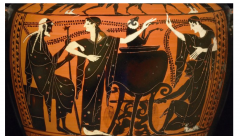
|
L - R: Pelias, Medea, Pelias' daughter Boiling the ram Medea displaying her socery through being able to give youth, old ram - young lamb Daughter believes, doesnt add herbs, kills Pelias and is forced to go into exile with Jason |
|
|
Jason and Medea in Corinth |
When exiled from Iolcus they go to Corinth This is where the plot of the Medea starts Chorus is 15 Corinth women |
|
|
Lost chest of Cypselus |
Once at Olympia in the temple of Hera in the Archaic period On the chest was a depiction of Jason and Medea wedding with Aphrodite present |
|
|
Glauce and Medea |
Daugher of King Creon that Jason marries Makes Medea mad She plots to kill them both, poisons golden robe and the crown She falls for wearing gifts and she dies |
|
|
Medea and Children |
Out of anger of Jason's marriage to Glauce she kills their sons to hurt him |
|

|
Furies in corners Jason bottom left Dead children bottom right Medea at center fleeing on a chariot of Helios (son God chariot) |
|
|
Medea and Aegeus |
After fleeing and killing her children she goes to Athens and meets and marries Aegeus |
|
|
Key-points in Euripide’s Medea |
Family Infidelity Nation Destructive emotions Justice Immigrant Mad Woman |
|
|
Medea after Aegeus |
Plotting against Theseus (long lost son of Aegeus) andfled from Athens also Went to Aria she caused its inhabitants to benamed after her Medes. |
|
|
Medea in the Modern World |
Icon of Feminism Speeches from the Medea are recited to-day at suffragist meetings. Movies, plays, art |
|
|
Eclecticism |
An idea that single paradigm or set of assumptions, but instead draws upon multiple theories, styles, or ideas to gain complementary insights into a subject Perfect example is Rome from Greek/ Hellenistic/ Etrscan influence took from art, religion, myth, literature |
|
|
She-Wolf Lupa |
Was believed to have taken in the twins Romulus and Remus who subsequently founded Rome Raised, nurtured, trained them |
|
|
Influence of Etruscan Art |
Very evident in the pillared temples by looking at the design |
|
|
Julius Caesar Octavianus |
27 BC Changed his name to Augustus when he became the first Roman emperor Dies 14 AD Very proud of what he was able to make of the roman empire |
|
|
Twelve Tables |
Created in 451/450 BCE Basic legal procedures and punishmentsFormally not abolished untilthe 6th cent. AD |
|
|
Capitoline Triad |
Juno, Jupiter, and Minerva Found in elaborate temple on Capitoline hill |
|
|
Capitoline Hill |
Similar to the greek Acropolis Temple of Jupiter Optimus Maximus |
|
|
Rhea Silvia and Mars |
Mother and father of Romulus and Remus She was a virgin priestess but she got knocked up by Mars |
|
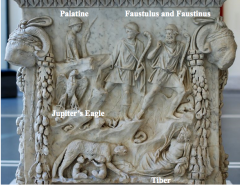
|
She-wolf nursing Romulus and Remus A personification of the river Tiber; Two fleeing shepherds, Faustullus, adoptive father of the twins, and his brother Faustinus. Personification of the Palatine, also dressed as a shepherd. The eagle of Jupiter indicates that events are unfolding under divine watch |
|
|
Faustulus |
Adoptive father of Romulus and Remus from the she-wolf Wife was Acca Larentia |
|
|
Roma or Remora? |
Competition between brothers to find a divine sign for who was going to be the ruler of the city they were going to est. Romulus - Saw many bird but after VICTORY Remus - Saw a bird first, but only one |
|
|
Birth of Rome |
April 21st 753 BCE |
|
|
The Pomerium |
Religious boundary around the city of Rome and cities controlled by Rome. In legal terms, Rome existed only within its pomerium; everything beyond it was simply territory belonging to Rome. |
|
|
Remus Conspiracy |
Possibly only invented in the 3rd Century Scholar Timothy Wiseman (1995) |
|
|
Lares |
Gods of the household |
|
|
Lares praestites |
Twins patrons and guardians of the city. |
|
|
Rape of the Sabine Woman |
First generation of Roman men abducted wives for themselves from the neighboring Sabine families Created tradition of carrying the bride into marriage house Expanded Roman territory and influence |
|
|
Death of Romulus |
Swallowed by a storm cloud Deified into the god Quirinus |
|
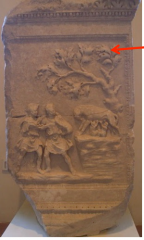
|
Ficus Ruminalis - The fig-tree under whichRomulus and Remuswere suckled near the Lupercal, Palatine Hill Shepherds discovering theshe-wolf suckling Romulusand Remus |
|
|
Lupercalia |
Feb 15 Festival to avert evil spirits and purify the city, releasing health and fertility In honour of the God faunus |
|
|
Saturnalia |
December 17 Saturnalia was an ancient Roman festival in honour of the deity Saturn Sacrifice at the Temple of Saturn, in the Roman Forum, and a public banquet, followed by private gift-giving, continual partying, and a carnival atmosphere that overturned Roman social norms: gambling was permitted, and masters provided table service for their slaves |
|
|
Matronalia |
March 1 According to the traditioninstituted by the Sabine kingTitus Tatius Procession to the temple ofthe goddess Juno Celebration of Juno and childbirth |
|
|
Matrona |
Married Woman |
|
|
Fasti Antiates |
Calendars that recorded religious festivals and events and stuff |
|
|
Rex Sacrificulus |
Or Sacrorum = King Sacrificer/ of the Sacred Was a senatorial priesthood position |
|
|
Regia |
The Regia was a two-part structure in Ancient Romea t the edge of the Roman Forum that originally served as the residence or one of the main headquarters of kings of Rome and later as the office of the Pontifex Maximus, the high priest of Roman state religion |
|
|
Forum Romanum |
Rectangular market place Important temples, offices, buildings |
|
|
Numa Pompilius |
Second king of Rome Romans attributed to Numa Pompilius severalreligious and cultural institutions, such as theestablishment of the Pontifex Maximus and theVestals |
|
|
Attus Navius and Tarquinius Priscus |
Attus Navius was a famous augur during the reign of Tarquinius Priscus |
|
|
Fortuna |
Goddess Was the goddess of fortune and personification of luck in Roman religion. She might bring good or bad luck She was associated with the cornucopia, ship's rudder, the ball and the wheel. The cornucopia is where plenty flows from, the rudder steers fate |
|
|
paterfamilias |
father of the household The paterfamilias had complete power of life and death over his familia (family) |
|
|
Links between Greek and Roman Myths |
Aeneas son of Anchises and Aphrodite (Venus)Ascanius, Aeneas’ son, founder of Alba LongaOdysseus and Circe’s two sons Numitor, Rhea Silvia’s father, king of Alba Longa |
|
|
Vesta |
Goddess of the hearth and home Had temples, found on coins Symbolized by the sacred fire that burned at her hearth and temples Priesthood = vestal virgins |
|
|
Vestalis Maxima |
Chief priestess of vestal virigins |
|
|
The Historicizing of Myth |
Link to real names, places, events, dates Example: Aeneas’son Ascanius was nicknamed Ilus. The name was then changed in Iulus linking him to the family of the Julii (powerful roman family) |
|
|
Gens Julia |
One of the most ancient patrician families at Ancient Rome Caius Julius Caesar Caius Octavius,later C. Julius Caesar Octavianusafter adoption by Caesar,and then Augustus, thefirst emperor of Rome |
|
|
Trajan’s column |
Is a Roman triumphal column in Rome, Italy, that commemorates Roman emperor Trajan's victory in the Dacian Wars Rome wanted to conqur the area of Danube |
|
|
The Politicizing of Myth |
Myths are used in order to justify politicalrealities Connections between domestic gods andstate gods Plebeian vs. Patricians |
|
|
Penates |
Gods of the household provisions |
|
|
pietas |
Respect for parents, gods, state |
|
|
Pax Romana |
"roman peace" State of order, regularity and harmony Augustus and Marcus Aurelius |
|
|
gravitas |
seriousness of purpose and devotion to duty |
|
|
frugalitas |
temperance, frugality |
|
|
Qualities of the Roman Hero |
Frugalitas Gravitas Pietas |
|
|
Horatius Cocles |
Officer in the army of the ancient Roman Republic who famously defended the Rome against the Etruscans - Example of Roman Hero |
|
|
Cincinnatus |
Roman aristocrat and statesman whose service as consul in 460 BC and dictator in 458 BC and 439 BC made him a model of civic virtue. |
|
|
Greek vs. Roman Herakles |
Worshipped at the Great Altar (Ara Maxima) in Rome The cult founded by Evander and the Arcadians after Hercules killed the bandit Cacus, who robbed the hero of the cattle of the giant Geryon |
|
|
Virgil |
Virgil (70-19 BCE), from Mantua Most famous for writing the Aeneid, died before he could finish Funded and supported by Augustus |
|
|
Aeneid |
12 Books It is primarily a work of fiction, but it contains also references to historical people and events. The first 6 books narrates the wandering of Aeneas after the fall of Troy. The second 6 books concern the bloodshed and battles, which Aeneas has to deal with in his quest to found a new city on the coast of Italy. |
|
|
Aeneas |
Hero of the Aeneid |
|
|
Diomedes and Aeneas |
At the end of the Illiad he is present for the Trojan war Is almost killed by Diomedes Rescued by Aphrodite and Apollo and then starts the story of the Aeneid |
|
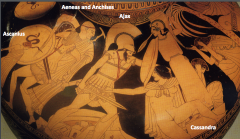
|
Sack of Troy Aeneas and his dad Anchises His son Ascanius Ajax and Cassandra |
|
|
Aeneas and Anchises |
Had to carry his father Anchises after his foot is hurt from the battle/ flames of Troy |
|
|
The Historicizing of Aeneid |
3 years Aeneas rules over Latium 30 years Ascanius rules in Alba Longa300 years Alba Longa capital of Latium |
|
|
The shield of Achillesvs.The shield of Aeneas |
Both were forged by Hephestus Many different modern depictions of his shield |
|
|
Battle of Actium |
The Battle of Actium was the decisive confrontation of the Final War of the Roman Republic, a naval engagement between Octavian and the combined forces of Mark Antony and Cleopatra on 2 September 31 BC, in Greece |
|
|
Dido’s curse |
Dido falls in love with Aeneas and then he leaves her When Dido sees Aeneas' fleet leaving she curses him and his Trojans and proclaims endless hate between Carthage and the descendants of Troy, foreshadowing the three Punic Wars. |
|
|
Hannibal the Carthaginian |
Was a Punic military commander from Carthage, generally considered one of the greatest military commanders in history. Led the Second Punic War and invaded Italy in 218 |
|
|
The Role of the City of Rome |
The walled city The commitment of its leader Bringer of civilization |
|
|
Aeneas and Lavinia |
After his betrothal to Lavinia, a local princess, daughter of the king Latinus, previously betrothed to a local prince, named Turnus. Aeneas marries Lavinia §Aeneas founds the city Lavinium |
|
|
Aeneas and King Turnus |
Fights Aeneas for the hand in marriage to Lavinia, princess of the Latins |
|
|
Death of Aeneas |
Aeneas dies and becomes a god Burried in a tomb Leaves Ascanius (son), now called Julus as his successor Founds the city of Alba Longa |
|
|
Aeneas as ideal Roman hero |
Sacrifices everything for a a promised land he never sees Obeys to divine orders Has self-control His rage is is not moved by his insulted ego, but by a deep sense of moral outrage |
|
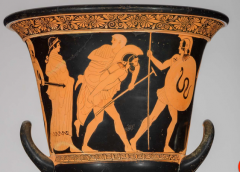
|
Aeneas, his father, Ascanius and Creusa escaping from Troy Cruesa is the wife/ mother to Aeneas son and helps them escape Troy but she died and comes to him as a ghost |
|
|
Aeneas and Marriage |
Marriage to Dido Marriage to Livinia Marriage in this story served the purpose of creating political/ economic pacts |
|
|
The family under the reign of Augustus |
Adultery and extra-marital sexbecame a public offence Marriage and children were a duty ofthe citizen to the state The power of the paterfamilias to killa daughter taken in adulterywas limited The divorce should be in front of witnessesPrivileges to those who had children Intervened in the private rightsof inheritance of the childless The emperor gave himself the right to intervenein family lawsuits |
|
|
Thetis vs. Venus |
Thetis helping Achilles is similar to the motif of Venus helping Aeneas |
|
|
Ovid |
Ovid (Publius Ovidius Naso) 43BCE-17 AD From Sulmona but lived in exile in Tomis maybe for hooking up with Augustus' grand daughter |
|
|
Metamorphoses |
15 books Deal with stories of creation, gods and heroes, but end with the death and deification of Julius Caesar transformed into a star Narrative links between the tales Critics to Augustan society |
|
|
Echo and Narcissus |
Echo was a nymph who was sent to Hera to distract her by chatting so Zeus could do whatever he wanted She was punished by Hera by not being able to speak before anyone else and could only repeat what someone said Echo was represented with wings (flying echo) and a covered face (echo doesn’t know who is speaking) She fell in love with Narcissus who was not interested in her love He was so proud of himself, liked looking on his reflection She eventually faded away so only her voice was left over |
|
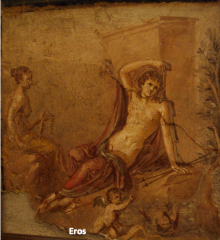
|
Narcissus andEcho |
|
|
Ovid's Four Ages |
Gold, Silver, Bronze, Iron Golden age is the best one - everything is very heaven like and blissful perfect In the Bronze age people had to start building shelters and plow the fields (agriculture) and seasons and stuff Iron Age - Sufferings and wars and bad stuff in life |
|
|
Perseus and Andromeda |
Perseus and Andromeda escape/ rescue Andromeda is rescued from underwater, chained up by Perseus Perseus in Ovid is not a brave or fighting hero Rather he defeats enemy by showing the head of Medusa and they get turned to stone |
|
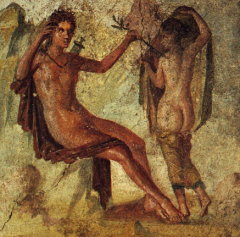
|
Apollo and Daphne He chased her but she didn’t want to have to have sex with him The name Daphne is linked to the word that means Laurell Daphne woke up with a ZNAKE on her body and she went home and purified herself similarly to when she had sex with her husband and then avoided public baths? Idk. |
|
|
Augustus and Apollo |
Augustus believed he had a specific relationship with Apollo House of Augustus and the temple of Apollo was built on the Palatine Hill in Rome Direct access from house to temple |
|
|
Orpheus and Eurydice |
She died trying to avoid the attention of another man and got bitten by a snake She died but Orpheus was so in love he convinced Hades and Persephone to take her back He is then killed by a Thracian women but not in Ovid's version |
|
|
Apollo andCyparissus |
Another male lover was Cyparissus, a descendant of Heracles. Apollo gave him a tame deer as a companion but Cyparissus accidentally killed it with a javelin as it lay asleep in the undergrowth. Cyparissus asked Apollo to let his tears fall forever. Apollo granted the request by turning him into the Cypress named after him, which was said to be a sad tree because the sap forms droplets like tears on the trunk. |
|
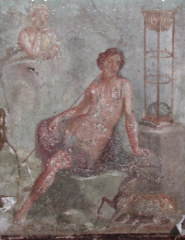
|
Apollo and Cyparissus Also a nymph and Apollo's tripod |
|
|
The death of Orpheus |
Orpheus at the end of his life disdained the worship of all gods except the sun, whom he called Apollo. One early morning he went to the oracle of Dionysus at Mount Pangaion to salute his god at dawn, but was ripped to shreds by Thracian Maenads (female followers of Dionyses) for not honoring his previous patron (Dionysus) |
|
|
Methods of transmission of classical mythology |
Ancient poems and plays in translation Reinterpreting and adapting ancient stories,plays, or poems Taking advantage of the audience’sfamiliarity with myth Using a specific mythic figure as an emblemor symbol |

